Hello, guys, In today’s this article we will study about Nucleus. Like – what is nucleus? Why is the nucleus called the control center of the cell? We will know the answers to many such questions today, so let’s start.
Why is the nucleus called the control center of the cell? and
What is the nucleus?
Nucleus is described as ‘control room’ of the cell. It directs and controls all the cellular activities. It was discovered by Robert Brown in 1931. During the life span of a cell, the nucleus exists in two phases.
- The Interphase or Metabolic phase
- Division phase
In this article, we will study about Interphase or Metabolic phase.
Who discovered nucleus?
Nucleus discovered by Robert Brown in 1931.
What is the shape and size of the Nucleus?
The interphase nucleus is also known as the metabolic nucleus, as it controls metabolic activities of the cell. It may be spherical, rounded, spheroidal, cylindrical, prismatic, branched or lobed.
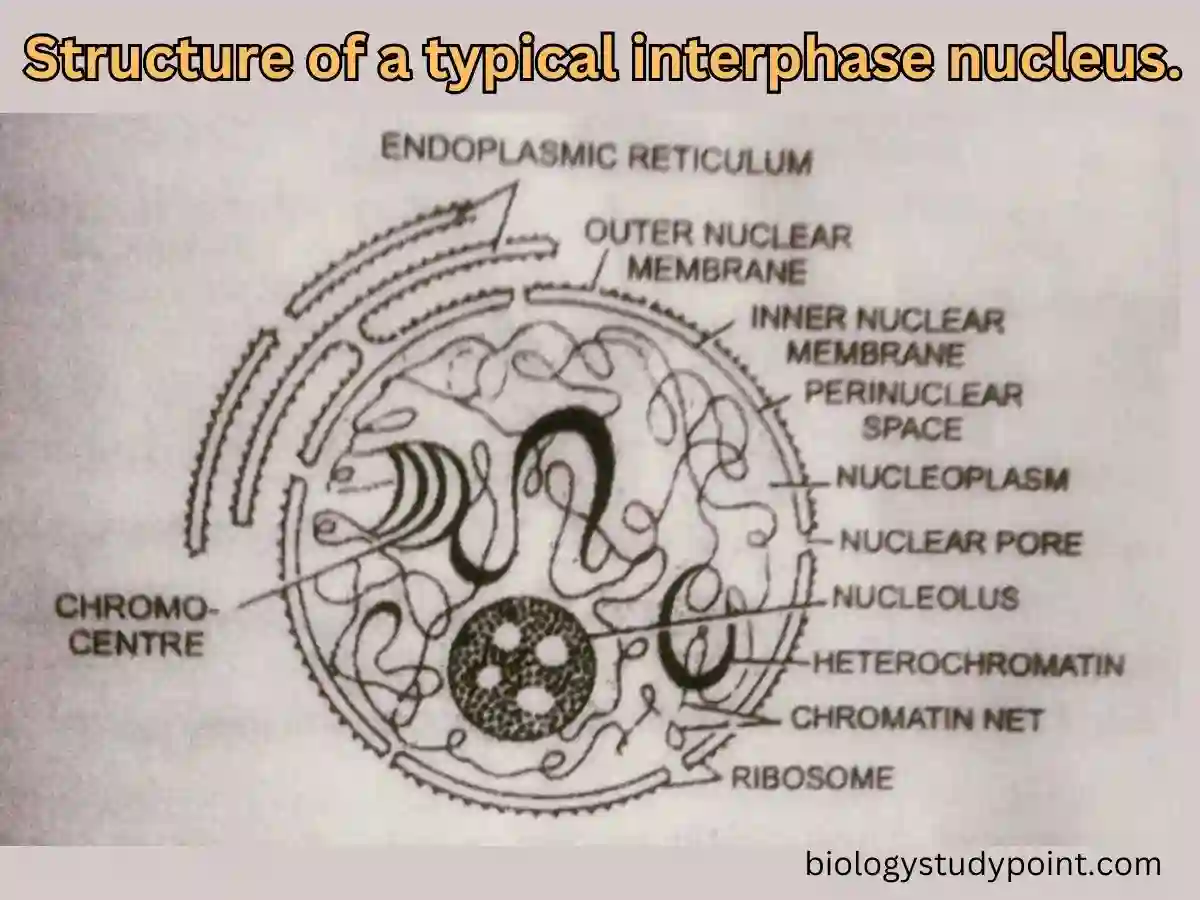
The size of nucleus is different in the cells of different organisms, in different cells of an organism and even in different stages in the same cell. The size is also related with the number of chromosome.
What is the nucleo-cytoplasmic ratio?
There is a definite proportion in the size of nucleus and amount of cytoplasm. This can be represented by the nucleocytoplasmic index (NP).
NP = Vn/Vc – Vn
Where Vn = Volume of nucleus
Vc = Volume of cytoplasm
Nuclear components of cell –
The interphase nucleus can be separated into the following parts.
- Nuclear envelope
- Nucleoplasm or ground substance
- Nuclear reticulum or chromatin net
- Nucleolus
- Chromocentres
What is the nuclear envelope or karyotheca?
The nuclear envelope is a double membranous sheath. It separates the nuclear material from the cytoplasm. It acts as a dynamic gateway between nucleus and cytoplasm and regulates nucleocytoplasmic interaction.
Nuclear membranes –
The two nuclear membranes of nuclear envelope are separated by a perinuclear space. This space is 20 nm in width. The nuclear membranes are 7-8 nm thick. The outer membrane has attached ribosomes. At places, it is continuous with the membranes of ER. The nuclear surface of the inner membrane is coated with filaments and fibres. These form a fibrous lamina or nuclear cortex.
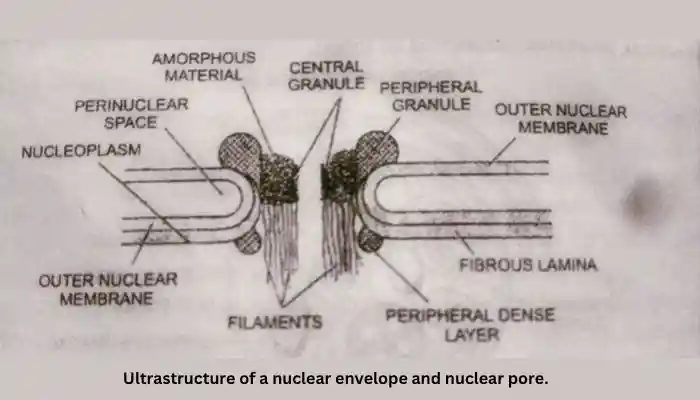
What are nuclear pores?
The nuclear envelope is perforated by pores. At the margin of these pores, the outer and inner nuclear membranes are continuous.
The nuclear pores are 100 nm wide circular channels. These are occluded by some electron dense material. This projects outward in the cytoplasm and inward into the nucleoplasm. These structures are called annuli. The two together form a pore complex.
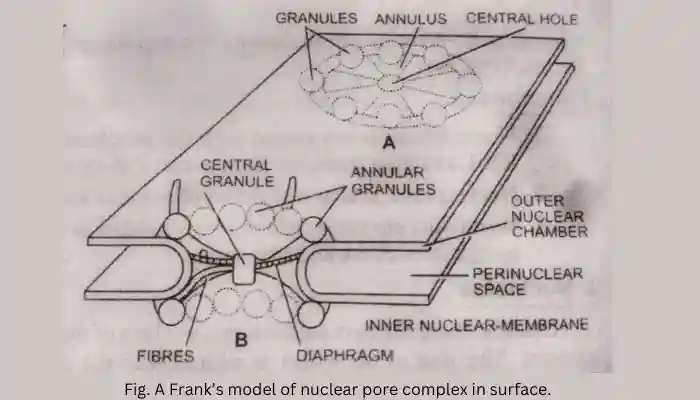
Each pore complex has an outer diameter of 90 nm, an Inner diameter of 25 nm, and a wall thickness of 30 nm. The electron dense material consists of fibrous and particulate structures. These are present along the margin of nuclear pore and form an annulus.
What is annulus?
Annulus appears as a ring or cylinder of electron dense material of nuclear pore. It is formed of two sets of eight evenly spaced annular granules. And a central granule. One set is arranged on the outer surface and the other set on the inner surface of the annulus.
The granules may be formed of compact material or fibrillar material. Fine fibres extend for the central annule to peripheral annular granules. Annuli around the pores regulate the exchange of macromolecules in relation to their size.
Fibrous or Nuclear laminar –
The inner surface of the nuclear envelope is plastered with a fibrous coating, called nuclear cortex. Its fibres are proteinaceous and similar to actin polymers. The fibres form funnel–shaped whorls. These funnels communicate with the nuclear pores and most probably direct material cortex functions as a funnel to come out of the nucleus.
The nuclear cortex functions as a funnel to direct materials towards pore channels. It also provides a supporting lamella.
What is the function of the nuclear envelope?
- The nuclear envelope separates the genetic components of the cell (Chromosomes) from the protein synthesis machinery.
- Nuclear pores serve for the transfer of macromolecules.
- Nuclear envelope provides a surface for attachment of structural elements of cytoplasm such as myofilament, microtubules and microfilaments.
- Interphase chromatin remains attached to the inner nuclear membrane.
- The nuclear envelope gives rise to membranes of ER and Golgi and participates in membrane flow.
- Nuclear envelope carries enzymes of electron transport system similar to those of endoplasmic reticulum.
What is nucleoplasm? Or What is nuclear sap?
It is the transparent ground substance. Chromatin network remains suspended in it. It is a mixture of proteins, large amount of phosphorus and some nucleic acids (RNA). A number of hydrolytic enzymes such as ribonuclease, alkaline phostophosphatase and dipeptidase are also found in the nucleoplasm.
What is the function of the nucleoplasm?
- Nucleoplasm is associated with the processing of newly synthesized RNA and their transport from nucleus to cytoplasm.
- Nucleoplasm acts as a skeleton of the nucleus and maintains the nucleus.
- It contains enzymes, and protein needed in the replication of DNA, synthesis of RNA and ribosome.
What is the nucleolus?
Nuclear Reticulum or Chromatin Net –
Embedded in the nuclear sap is the network of twisted filaments or threads, which are known as chromonemata and their network as nuclear reticulum or chromatin net. It contracts and organizes into a distinct chromosome during cell division.
Euchromatin and heterochromatin –
The cell chromatin can be differentiated into two types. The fine thread-like linen of the chromatin, which stains lightly with basic dyes, is called euchromatin. At certain regions, the chromatin is condensed and darkly stained. This is known as heterochromatin.
The heterochromatin regions can be seen in the interphase and prophase. It does not unravel in telophase like the remaining euchromatin.
The euchromatin also exhibits different affinities to the dyes. The linen of the chromatin which is in the form of lightly stained threads is composed of a chromatin (Stains with acidic dyes) and the darkly stained-granules (chromomeres) present on the linen are formed of basichromation or chromatin proper.
In some cases, the largest regions of the nucleus take dark stains with basic fuchsin. These are known as chromocentres of karyosomes.
Special sex chromatin bodies or barr-bodies are found in the periphery of the nucleus. These are more common in mammalian cells and especially females. Their number usually depends upon the number of sets of X -chromosomes. Normally, there is one sex chromatin body for a diploid set of chromosomes.
What is chromocenter?
In the interphase nucleus of certain cells, some areas of considerable size take darker stain than the rest of the chromatin. These darkly stained areas are actually heterochromatic regions of the chromosomes which are pron to premature condensation.
There can be only one or many heterochromatic regions of several chromosomes, or of all the chromosomes of the nucleus. The chromocenter is well-marked in the nuclei of salivary gland cells of Drosophila.
What is the function of nucleus?
The nucleus is the controlling center of the cell. It controls all the metabolic activities of the cell by controlling the synthesis of enzymes required there in. the nucleus controls the inheritance of characters from parents to offsprings. It is responsible for the development of characters.
What we are and how we look like is determined by genes we have inherited from our parents. These genes are present in the chromosomes of the nucleus. A number of experiments conducted by scientists illustrate the role of nucleus.
Hammerling’s Experiment to demonstrate Importance of nucleus –
A German biologist. J. Hammerling, in 1934 demonstrated that nucleus controls the functioning of cells and ultimately the characters of the individuals by conducting experiments on Acetabularia, a green alga. Two species of Acetabularia : A. crenulata and A. mediterranea differ in the shape of their caps.
In A. crenulata the cap is digitate having loose rays, whereas in A. mediterraneta the cap is umbrella–like. In both species, the nucleus lies at the bottom of the stalk in the rhizoid. Acetabularia possesses the power of regeneration. If its cap is cut off, it is regenerated again. However, if after removing the caps, the stalk of one species is grafted on the rhizoid of the other (note that rhizoid).
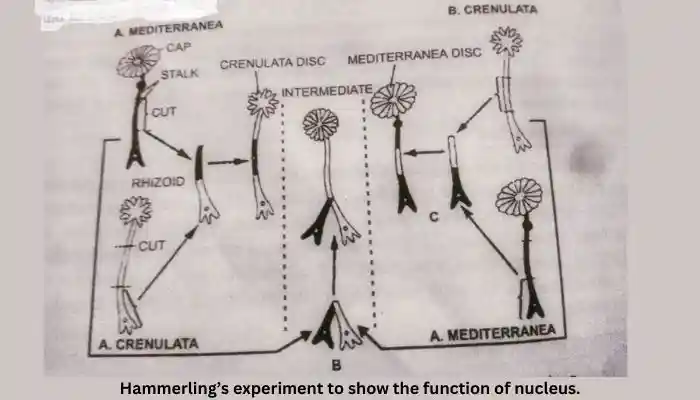
As the carrier of the nucleus) the shape of the cap on the grafted Acetabularia is found to be determined by the nucleus present in the rhizoid (not by the rhizoid). If the nucleus belongs to A. crenulata, the cap is digitate or crenulate type and if it belongs to A. mediterranea, the cap developed is mediterranean type. When both the nuclei are present, the shape of the cap is found to be intermediate.
This clearly indicates that the characters of an individual are controlled by the nucleus.
What is the nucleolar cycle?
The nucleolus as an organized body is lacking in continuity, During mitosis, it undergoes cyclic changes. It disappears at the beginning of cell division (prophase, and is formed again at the end of cell division in telophase.
The nucleolus is formed at a definite region by one or more chromosomes of a haploid set. Such chromosomes are known as nucleolar chromosomes. The majority of diploid species possess two nucleolar chromosomes in each diploid or somatic cell.
But in man chromosomes numbering 13, 14, 15, 21 and 22 participate in the formation of nucleolus. The specific region of these chromosomes active in nucleolar formation is known as nucleolar organizer zone or nucleolar zone. Very often but not always it is marked by secondary constriction. The nucleolar organizer carries genes for 18S and 28S ribosomal RNA.
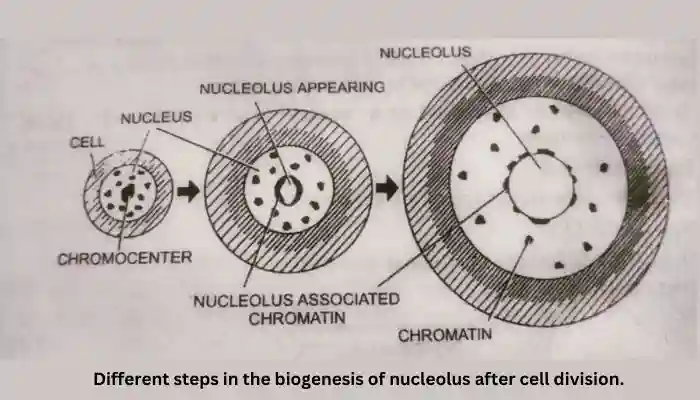
During prophase, the amorphous part of the nucleolus disappears, and the chromatin loop is withdrawn into the nucleolar organiser region of the corresponding chromosome. During telophase, nucleolus is reorganized in the following two steps.
- The convoluted chromatin loop uncoils from the nucleolar organizer and gets surrounded by fibrillar and granular material. These are produced from the chromocentre of the interphase nucleus.
- The nucleolus matrix and its basic proteins and RNA (the nucleolar substances) are produced within the chromocenter and are liberated in small perinucleolar bodies. These fuse to form the mature interphase nucleolus.
What is nucleoproteins?
Nucleoproteins are the major and the most important component of nucleus. These are compounds of nucleic acids and proteins. The proteins present in the nucleus are specific and are separated into two categories.
- Basic proteins
- Nonhistone acid proteins.
What are basic proteins?
These are low molecular weight proteins having molecular weight ranging from 1000 to 12000. These are basic in nature. The amount of basic proteins is proportional to the amount of DNA with which they are intimately associated.
The chief basic proteins found in the nucleus are protamines and histones. The histones are more widely distributed and are composed of lysine and arginine. These from about 55% of the total chromatin material. The protamines are restricted in their distribution and are found mainly in fish spermatozoa. These are rich an arginine.
What is nonhistone or acid proteins?
The nonhistone proteins are acidic in nature and usually equated with the residual proteins of the chromosomes. These contain tryptophan and tyrosine. These nonhisotone proteins differ from histones in the presence of higher concentration of tryptophan contents.
Their amount chiefly depends upon the physiological activity of the cell. The nonhistone or residual proteins are said to perform the special metabolic functions of the nucleus.
The nucleoproteins in the chromatin material or the chromosomes serve as a framework to which the different nucleic acids are attached. In addition, the nucleohistones are concerned with the maintenance and reproduction of chromosomes and nucleononhistones are concerned with the special metabolic function of the nucleus.
What is euchromatin and heterochromatin?
What is heteropyknosis?
Heteropyknosis (Gr. Differential staining) is the property of certain chromosomes or their parts to remain more condensed and stain more intensely than other chromosomes or their parts during the nuclear cycle.
Conclusion –
So friends, in today’s article we have studied Why is the nucleus called the control center of the cell. Friends, if you like this article, then please comment, share and tell your suggestions and our mistakes.
Thank you so much